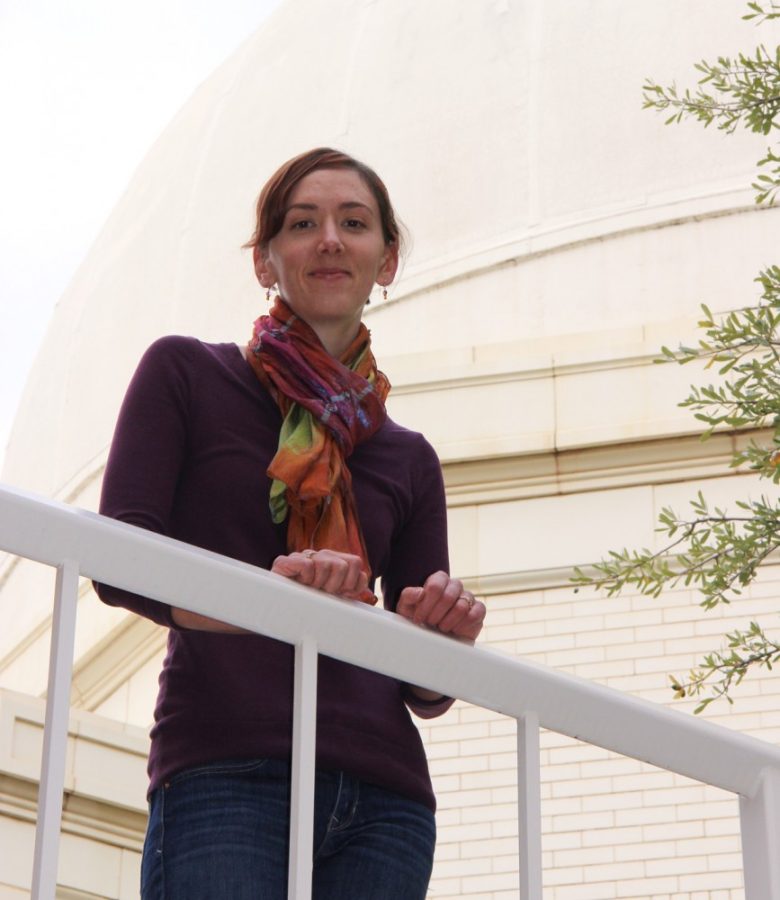A UA graduate student’s research recently led to the discovery of a planet that has many astronomers rethinking planet formation.
The planet, dubbed HD 106906 b, is a gas giant orbiting its parent star at a distance 650 times greater than the distance between the Earth and the sun. It was imaged with a telescope that utilizes several instruments developed at the UA.
The finding of such a massive planet orbiting so far from its parent star is unprecedented, said Vanessa Bailey, the graduate student in the Department of Astronomy who led the research.
In fact, the exoplanet, which is 11 times more massive than Jupiter, is the “most distantly orbiting planet that anybody’s been able to find around a single sun-like star,” Bailey said.
The imaging of the planet was done using the Magellan Telescope in Chile, which uses unique, UA-developed technology to counteract the twinkling of the stars.
Due to the natural turbulence of the atmosphere, stars appear blurry when imaged directly. The resulting glare can hide finer structures within the system, such as planets, said Laird Close, a professor in the Department of Astronomy.
To eliminate the glare, Close uses the Magellan Adaptive Optics system, which deforms the small secondary mirror of the telescope 1,000 times per second to correct for the disturbances caused by the air.
“You click a mouse button and it goes from being a blurry, fuzzy image to being an ultra-sharp image,” Close said, “and then faint little things around the star, like a planet, can be seen.”
Using the MagAO technology, the team was able to image the planet in the infrared, as opposed to the visible light spectrum. The discovery of such an oddball planet came as a surprise to Close, who doubted they’d find anything significant around the star.
“It’s like so many things in observational sciences,” Close said. “Nature is once again stranger than we had suspected.”
What makes the planet unique is that a body with so much mass orbiting at such a great distance from its star doesn’t fit with the conventional models of planet formation.
Earth is thought to have slowly coalesced from the material — gas and dust — that billions of years ago collected around the sun in what is referred to as a protoplanetary disk. HD 106906 b, on the other hand, is so far away from its host star that this type of formation is unlikely because most protoplanetary disks don’t extend that far, Bailey said.
The other major theory of planet formation, which pertains more to gas giants like Jupiter, Saturn and the UA-discovered sphere, is that a clump of material in the disk leads to a relatively rapid collapse, forming a large gas planet.
“The problem with that, again, is that these initial protoplanetary disks, we don’t think that they have enough material out at [that distance] to collapse into an 11-Jupiter-mass object,” Bailey said.
As for how the planet actually formed, Bailey said she is leaning toward a theory that posits that the new world isn’t a beefy planet, but a puny star whose development was stunted.
Bailey added that stars sometimes form as a binary system, in which two stars form near each other. It may be the case that the newly discovered planet was on its way to becoming a star before it was “starved” of the necessary material. However, the extreme difference in mass between the planet and the star is inconsistent with any of the ratios observed in binary systems, she said.
The researchers’ findings were published on Tuesday in The Astrophysical Journal Letters. They will continue to study the newfound planet in hopes of unveiling its mysterious origins.
“To be able to work on something that’s cutting edge … and to have all that hard work pay off in the end and do something amazing like discover a planet — it’s a really good feeling,” said Jared Males, a postdoctoral scientist in the Department of Astronomy. “It’s absolutely incredible.”
– Follow Mark Armao @MarkArmao









